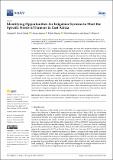| dc.contributor.author | Van de Zande, Georgia D. | |
| dc.contributor.author | Amrose, Susan | |
| dc.contributor.author | Donlon, Elliott | |
| dc.contributor.author | Shamshery, Pulkit | |
| dc.contributor.author | Winter V, Amos G. | |
| dc.date.accessioned | 2024-01-10T15:05:36Z | |
| dc.date.available | 2024-01-10T15:05:36Z | |
| dc.date.issued | 2023-12-24 | |
| dc.identifier.uri | https://hdl.handle.net/1721.1/153295 | |
| dc.description.abstract | East Africa (EA), a region facing food shortages, has very little irrigation adoption compared to the rest of the world. Increasing irrigation has been shown to increase food cultivation, so governments and private organizations have been attempting to introduce irrigation products into the EA market. Despite this support, irrigation adoption rates remain low, reflecting that existing solutions do not meet the needs of medium-to-small-scale farmers. Meeting these needs is challenging due to the diversity of farmers in EA and the minimal exploration of these differences in the literature. This study sought to elucidate some of these differences and explore whether new opportunities exist for irrigation products targeting EA farmers. An interview-based market assessment was first conducted to identify key market segments and unique values that farmers in each segment may hold for an irrigation system for each segment. Then, a techno-economic feasibility analysis was used to reveal which combinations of irrigation methods and energy sources present promising opportunities for each segment. Four distinct market segments were found. Broadly, the traditional smallholder would likely most value a system that uses photovoltaic (PV) power and manual irrigation. The semi-commercial smallholder may find promising opportunities in a system that uses PV power and butterfly sprinklers. Both the medium-scale contract farmer and the remote farm owner would likely value PV panel- and drip irrigation-based systems. These identified opportunities can guide innovation for irrigation designers as they create new systems to directly serve the needs of specific market segments, with the aim of increasing irrigation and food security in EA. | en_US |
| dc.publisher | Multidisciplinary Digital Publishing Institute | en_US |
| dc.relation.isversionof | http://dx.doi.org/10.3390/w16010075 | en_US |
| dc.rights | Creative Commons Attribution | en_US |
| dc.rights.uri | https://creativecommons.org/licenses/by/4.0/ | en_US |
| dc.source | Multidisciplinary Digital Publishing Institute | en_US |
| dc.title | Identifying Opportunities for Irrigation Systems to Meet the Specific Needs of Farmers in East Africa | en_US |
| dc.type | Article | en_US |
| dc.identifier.citation | Water 16 (1): 75 (2024) | en_US |
| dc.contributor.department | Massachusetts Institute of Technology. Department of Mechanical Engineering | |
| dc.identifier.mitlicense | PUBLISHER_CC | |
| dc.eprint.version | Final published version | en_US |
| dc.type.uri | http://purl.org/eprint/type/JournalArticle | en_US |
| eprint.status | http://purl.org/eprint/status/PeerReviewed | en_US |
| dc.date.updated | 2024-01-10T14:50:11Z | |
| dspace.date.submission | 2024-01-10T14:50:11Z | |
| mit.license | PUBLISHER_CC | |
| mit.metadata.status | Authority Work and Publication Information Needed | en_US |
